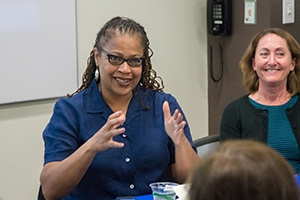American University Professor to Present Research on Gentrification, “Faux-Diversity” in the District

Kogod professor Sonya Grier at a panel discussion in the University Library.
In cities that are rapidly gentrifying, intentional and unintentional tensions between new and longer-term residents threaten to erode a sense of community built up over generations, according to new research from a professor at American University. Sonya Grier, professor of marketing at the university's Kogod School of Business, will present the findings from a forthcoming paper, "Dogparks and Coffee Shops: Faux Diversity and Consumption in Gentrifying Neighborhoods" on Tuesday, February 27 at 4 p.m. at "The Forum @DC."
The gathering brings together members of the research community in and around Washington D.C. to present and discuss research that can inform the improvement of programs and policies in District government.
"Faux diversity," a term coined by Grier and her co-author, is the presence of diverse groups without interaction, a diversity that is superficial, temporary, fleeting, and misleading.
The study focused on Columbia Heights, Petworth and the U Street Corridor. They interviewed both new and longer-term residents ranging 23 to 70 years of age to examine how demographic changes that accompany gentrification relate to consumption.
Grier, and her co-author, Vanessa Perry form George Washington University, initiated the research after noticing segregated diversity in the district.
"We were hanging out at U Street Music Hall and noticed that despite the diversity of people, they were not interacting," Grier said "It was segregation within diversity. Yet we also knew that research shows people want to live in diverse areas. We set out to explore diversity in the context of consumption given we are both marketing professors."
One of the prevailing narratives from older Washington residents was the sense of loss, as businesses that were longtime staples of communities began to change. Don*, a 25-year resident, lamented the changes in his neighborhood and Ben's Chili Bowl in particular.
"I remember I was here during the metro construction and Ben's was almost going out of business," he says. "I would literally go and buy a hot dog from Ben's just to help them out. They've come along way. They don't need my help anymore… What's amazing to me is that the last time I went to Ben's, at lunch time and looked around, I was the only African American person in Ben's Chili bowl. I said 'Oh my goodness! Look at this. I'm the only Black person in Ben's Chili Bowl! And that's just how the neighborhood is now."
The researchers also found that newer residents who were seeking out racial and ethnic diversity when settling in Washington were surprised to find out how homogeneous some of that establishments they frequented had become. Despite living in diverse areas, a "faux diversity" developed.
"You would think that in a diverse neighborhood you would have people of all backgrounds in that restaurant," said Monty, a Caucasian resident who has lived in Washington for a year. "But its people just like me, so where's the diversity?"
Grier and her colleague believe that marketers, along with policymakers and consumer advocates have a role to play to counter "faux diversity."
As Grier notes, "Both public and private consumption opportunities involve social interaction critically important to developing cross-group relationships and harmonious communities."

